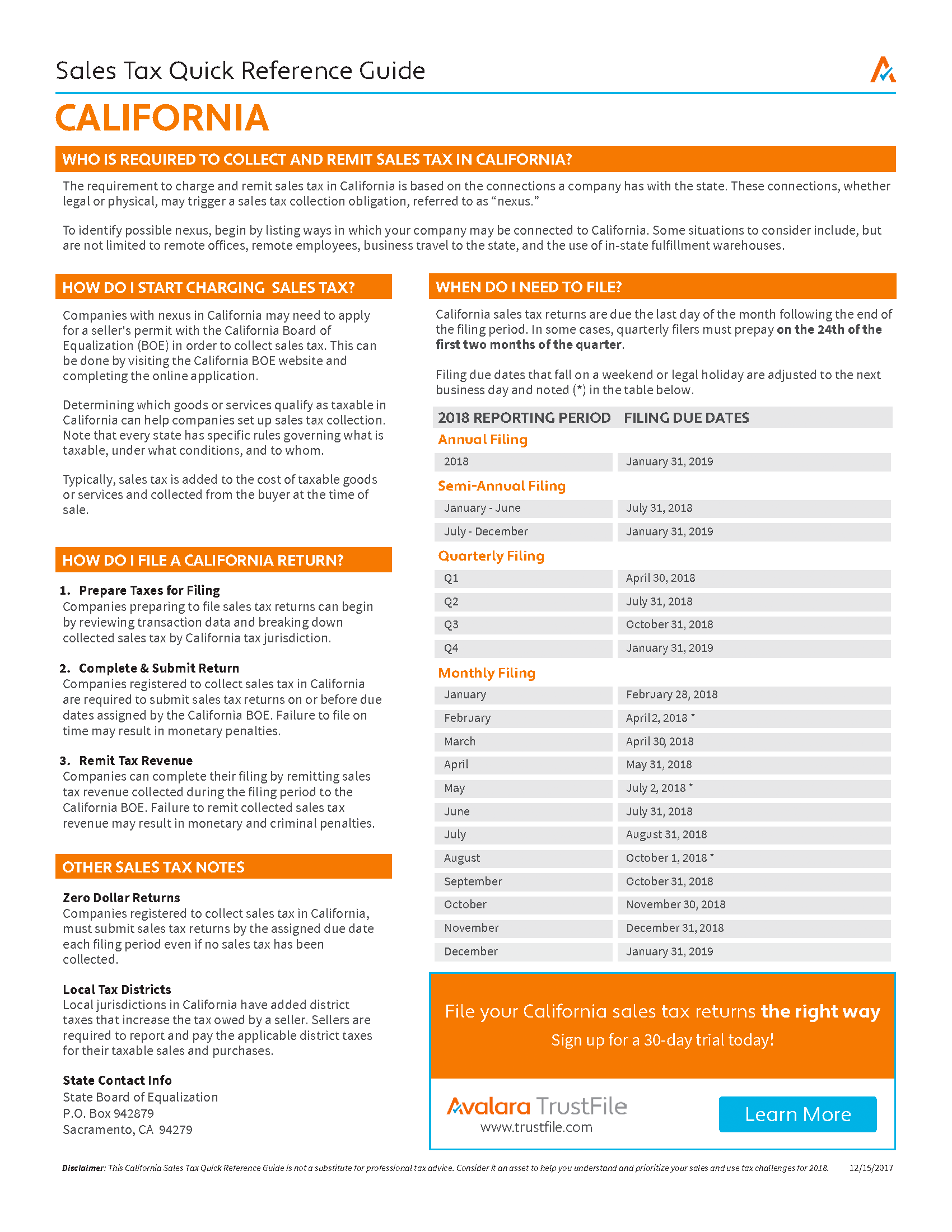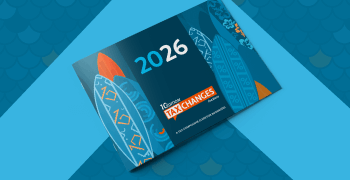California will tax sales by out-of-state sellers starting April 1, 2019
Update 7.15.2019: Due to the enactment of Senate Bill 92 in late June, the district tax ordinance is effective April 25, 2019, rather than April 1, 2019. The California Department of Tax and Fee Administration (CDTFA) explains that the date change "eliminates the retroactive effect of AB 147 with regard to the new district use tax collection requirement." See the CDTFA for more details.
Update 4.26.2019: The California Legislature has increased the economic nexus threshold. Retroactively as of April 1, 2019, an out-of-state seller must register with the California Department of Tax and Fee Administration (CDTFA) and collect and remit California sales and use tax if its total combined sales of tangible personal property for delivery in the state exceed $500,000 in the preceding or current calendar year. The 200 transactions threshold is eliminated. In addition, as of October 1, 2019, marketplace facilitators must collect and remit sales tax on all sales made through the marketplace in California. See AB 147 for more details.
After months of deliberation, the California Department of Tax and Fee Administration (CDTFA) has come up with a response to South Dakota v. Wayfair, Inc., the decision by the Supreme Court of the United States that overruled the physical presence rule preventing states from taxing remote sales. California will require out-of-state sellers with a certain amount of economic activity in the state to collect and remit sales tax* starting April 1, 2019.
The significance of this can’t be overstated. Although California is the 30th state to adopt economic nexus in the wake of the Wayfair decision, it’s by far the largest to do so. With a population pushing 40 million and the fifth largest economy in the world, few if any retailers will remain unaffected by this new collection requirement.
Prior to the Supreme Court’s decision in South Dakota v. Wayfair, Inc. (June 21, 2018), states only had the authority to impose a sales tax collection obligation on businesses with a physical presence in the state. In Wayfair, the court found the physical presence constraint to be “unsound and incorrect.” It determined that a business with no physical presence in a state could establish nexus through its “economic and virtual contacts” with the state.
What triggers economic nexus in California
Like most other states that have adopted economic nexus, California is allowing an exception for small sellers. Its new collection requirement applies to out-of-state retailers that, in the current or preceding calendar year, have:
- More than $100,000 in taxable sales in California, or
- At least 200 separate transactions for delivery into California
What sales are subject to sales tax in California?
Retailers meeting one or both of the above thresholds will have to register with the CDTFA and collect and remit tax on their sales of tangible personal property to California consumers starting April 1, 2019.
California sales tax doesn’t generally apply to services unless the service is part of a sale of tangible personal property.
Digital goods and services (e.g., ebooks, computer programs, and streamed music and movies) are not generally subject to California sales tax unless the purchaser also obtains tangible personal property (e.g., storage media) as part of the transaction.
What sales tax rate applies to each sale?
All taxable sales in California are subject to the statewide sales tax rate of 7.25 percent, which includes a mandatory local sales and use tax rate. Sales may also be subject to district sales taxes, which are imposed locally and vary by location.
According to the CDTFA, both in-state and out-of-state sellers are required to collect applicable district use taxes if they are “engaged in business” in the district.
Prior to April 1, 2019, a retailer is “engaged in business” if it maintains a physical presence in the district; has representatives (etc.) operating in the district to make sales or deliver, install, or assemble tangible personal property in the district; leases tangible personal property in the district; or other.
Starting April 1, 2019, out-of-state retailers and in-state retailers with economic nexus in the district (i.e., more than $100,000 in sales or 200 transactions in the district) are required to collect all applicable state, local, and district sales and use taxes in the district.
When do retailers need to start collecting California sales tax?
A business that made retail sales into California in 2018 is required to register with the CDTFA and collect and remit California sales tax starting April 1, 2019, if its taxable sales in the state in 2018 totaled more than $100,000, or it made 200 or more separate taxable transactions for delivery in California.
A business that didn’t meet the sales and/or transaction threshold in 2018 is not required to register and commence sales tax collection and remittance on April 1, 2019.
However, a business that meets the sales and/or transaction threshold at any time during 2019 is required to register with the CDTFA and commence sales tax collection and remittance as soon as the threshold has been met.
The CDTFA provides this example:
- Your sales into the state total $99,000 as of September 30, 2019
- You make a sale of $500 on October 5, 2019, and $300 on October 6, 2019, and $400 on October 7, 2019
- You’re required to register with the CDTFA on October 7, 2019, and collect and remit sales tax immediately, because your sales into the state in 2019 have surpassed the $100,000 threshold
- You’re not liable for collecting tax on the $400 transaction that put you over the $100,000 threshold. “Your customers will remain liable for the payment of the use tax on these transactions.”
Can retailers be held liable for tax on retail sales made in California prior to April 1, 2019?
The CDTFA will enforce economic nexus prospectively. Businesses that weren’t “engaged in business” in California before April 1, 2019, generally won’t be held liable for tax due on their sales into the state prior to April 1, 2019.
Businesses that were “engaged in business” (i.e., have nexus) in California prior to April 1, 2019, could be held liable for taxes owed on those sales. Activities that trigger nexus in California before April 1, 2019, include, but aren’t limited to:
- Having a physical presence in California (including maintaining inventory in the state)
- Having representatives in California for the purpose of taking orders, making sales, or assembling or installing tangible personal property
- Receiving rental payments on leased personal property located in California
Do out-of-state retailers owe tax on sales made through an online marketplace?
If your sales into the state (including sales made through one or more marketplaces) surpass either economic nexus threshold, you’re responsible for collecting and remitting California sales tax.
Some marketplaces collect and remit on behalf of their sellers. Businesses should contact all marketplaces through which they sell to determine which, if any, collect and remit on their behalf.
What next?
If you engage in business in California, you need to determine if your sales into the state surpass the sales or transaction threshold. A good place to start is Avalara’s state-by-state guide to sales tax nexus rules. It’s also a good idea to speak with a trusted tax advisor or the California Department of Tax and Fee Administration to determine your next steps. For additional information, see the CDTFA.
*Sales tax in California is imposed on retailers and generally applies to their gross receipts from retail sales of tangible personal property in the state. Use tax is imposed on consumers; when a retailer doesn’t collect sales tax on a taxable sale, the consumer generally owes the state the equivalent use tax. In addition, California law requires out-of-state sellers who are “engaged in business in this state” to collect and remit the California use tax owed on their sales to California consumers. For simplicity’s sake, we’re referring to the tax owed by remote retailers in California as sales tax.

Avalara Free Tax Guides
California Sales Tax Reference Sheet
A handy reference for businesses filing California sales tax returns.

Avalara Tax Changes 2026 is here
The 10th edition of our annual report engagingly breaks down key policies related to sales tax, tariffs, and VAT.
Stay up to date
Sign up for our free newsletter and stay up to date with the latest tax news.














